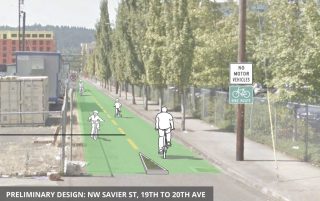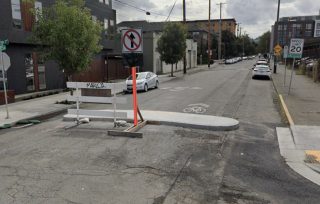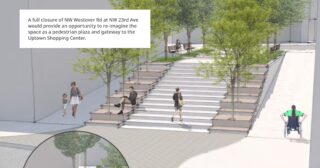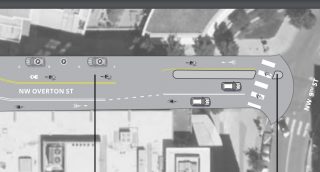
When a seven-page memo detailing changes to the Northwest in Motion plan was released late last month by the Portland Bureau of Transportation, many advocates were animated in their disapproval.
“All the ways in which Northwest in Motion is being watered down is so incredibly depressing,” NextPortland blogger and transportation reform activist Iain MacKenzie shared on Twitter.
NWIM is the city’s plan to dramatically increase biking, walking and transit use in the Northwest District. When we shared the draft plan back in November it came with an expectation that the projects would double bike use. In the past two years of planning, PBOT has identified a list of projects that are truly unprecedented for this part of town. From five new neighborhood greenways and a district-wide 20 mph speed limit zone, to carfree streets and 12 new diverters that are estimated to take 12,000 cars off the road every day.
So when the “Revisions Memo” came out with significant changes to some of the more exciting elements of the plan, it’s easy to see why some people were a bit crestfallen. We’ve seen this movie before: PBOT teases bold projects that get us dreaming of a new future — then they water them down or give up on them completely when pushback arises.
Here are some of the changes that have raised eyebrows:

Diverter at NW 20th and Raleigh: PBOT installed a full diverter in the southern leg of the intersection as part of their 20th Ave LID project.
Now PBOT says:
“Since installation, we have heard significant concerns from residents, businesses, and property owners about how the design of the diverter negatively impacts neighborhood circulation and access to on-street parking. We have also heard concerns from PBOT staff and developers in the Slabtown area that this full diverter design is inconsistent with the Conway Master Plan and is also inconsistent with the other diverters we have proposed in Northwest in Motion, which are usually semi-diverters that only impact one direction of traffic at a time. PBOT agrees that the design of this diverter is problematic and that it should be modified in the near future to better match the overall diversion strategy. We plan to make 20th Ave one-way northbound for traffic from Quimby to Raleigh, with a contraflow bike lane, similar to the design on 20th Ave from Everett to Flanders. Just like our approach to diversion on other neighborhood greenways, we will commit to monitoring the effectiveness of the diverter and if northbound volumes increase on 20th Ave in the future to an unacceptable level we will re-engage the public around adding another diverter further south on 20th Ave, for example near Lovejoy or Northrup.”
NW Overton Neighborhood Greenway: Proposal was a striped bike lane on the south side made possible by removing all auto parking from 9th to 11th.
Now PBOT says:
“We heard concerns from small businesses and residents along NW Overton St from 9th to 11th that the amount of on-street parking removal, including all parking on the south side, would have a negative impact on the viability of the businesses along the street. In response, PBOT staff met with concerned business owners and residents and explored various options and alternatives in more detail. A major point of concern was that our proposal only left Overton easily accessible from the west, but all the remaining parking would be in the opposite direction. This seemed to be a legitimate concern as it would make circulation difficult and may dissuade people from visiting and parking in the area.
The project team took a look at options and realized that on-street parking could be restored on the south side of the street without compromising the neighborhood greenway connection…. we believe that bikes will have adequate time to travel along Overton eastbound without being passed or closely followed by motor vehicles [Note: It will now be a shared-street environment with no dedicated bike space.]. The revised proposal will still have a diverter for the westbound direction at 9th Ave, but to ensure it can be easily used as Major Emergency Response Street we will revise the graphic to show a striped bike lane with no concrete island.”
NW Savier between 19th and 20th: One of the more exciting proposals of the plan was a carfree street at this location.
Now PBOT says:
“Revise NW Savier St proposal from 19th to 20th to allow two-way motor vehicle traffic while still calming traffic and ensuring a low-stress environment. We received feedback from property owners and developers in the rapidly-developing Slabtown area, as well as from PBOT Development Review staff, that the proposed changes to NW Savier St were inconsistent with the adopted Conway Master Plan and would unduly hinder development in the area… The project team is comfortable removing the proposed car-free street, because we can monitor traffic volumes and could propose diverters further east or west of the Conway area in the future as needed…”
Advertisement

NW 23rd and Westover: Initial proposal was for a carfree plaza on this block north of 23rd.
Now PBOT says:
“We received a great deal of feedback expressing concerns about the proposed closure of NW Westover Rd to traffic as it approaches NW 23rd Ave. Feedback included concerns about potential difficulty programming a plaza space in that context due to the steep slope and lack of ground-floor activity, concerns about loss of on-street parking in a high-demand area, and the impact of traffic that would be directed to Everett and 23rd. Overall, there was a strong theme in the feedback that people felt Westover should remain open to traffic to preserve access and circulation in the constrained area around the Uptown Shopping Center.”
NW Everett Bike Lane: Not part of NWIM, but PBOT gets constant criticism about this bike lane that was installed in 2014 (this coverage in NW Examiner probably hasn’t helped).
Now PBOT says:
“We have also heard continuing frustration with the design of NW Everett St… The main concern seems to be a perception that the space is inefficiently used because bike volumes are low while traffic queues in the single remaining motor vehicle lane… PBOT has justified the project based on the need for basic bike network connectivity… this justification may not continue to make sense once the Flanders Bridge is constructed over I-405, as people biking will then have a low-stress and high-quality connection to and from the Pearl District… We continue to think that any decision to convert the bike lane to other uses should wait until after we can measure what happens to bike travel after the Flanders Bridge is constructed.”
Advertisement
So, what do advocates think of these changes? And how does PBOT justify them?
“Even with the negative changes, there is still a lot for advocates to celebrate in this plan.”
— Reza Farhoodi
Reza Farhoodi is planning and transportation committee co-chair for the Pearl District Neighborhood Association and is a member of the NWIM Community Advisory Group. “Even with the negative changes, there is still a lot for advocates to celebrate in this plan,” he wrote on the Bike Loud PDX email list last week. Farhoodi says the myriad diverters still in the plan will be “transformational” and bring northwest its first real, functioning neighborhood greenways. He also thinks it would be a big mistake for fellow activists to oppose the plan and jeopardize all the work that’s been put into the plan thus far. “I fear that framing this conversation around citywide parking policy (or why these are greenways and not protected bike lanes) will further fracture public opinion and risk setting back safe streets in NW for years to come.”
For their part, PBOT says the revisions are relatively minor when compared to everything else proposed in the plan. They say they’re obligated to address concerns about projects and their hands are tied due to the Conway Master Plan.
I talked to PBOT Public Information Officer Dylan Rivera and NWIM Project Manager Zef Wagner on the phone this morning. “That memo is about some really small refinements to a very large ambitious action plan that amounts to the biggest moves PBOT has made to create low-stress biking on a neighborhood and network scale in the city’s history,” Rivera said at the outset of our conversation.
“Some felt that the plan did not consider the needs of those who are automobile dependent and expressed concerns about the loss of parking.”
— from PBOT’s public feedback review summary
Wagner said PBOT is just doing their job. “When we get feedback from people… we’re obligated to look at the project and see if there’s a solution and find a way to deal with concerns without compromising the project.”
Asked about taking carfree NW Savier off the table, Wagner said the Conway Master Plan is a legally binding agreement with the City of Portland that takes precedence over other plans. PBOT can propose street designs and negotiate with Conway about them; but at the end of the day they must come to agreement. Wagner added that developers are “excited” about a special, low-car design of the street, but the carfree idea is a step too far. “They’re concerned because properties will be developed on both sides [possibly including a new hotel] and are feeling very hemmed in… they feel they need some access there.”
Advertisement
When it comes to the carfree block of NW Westover, Wagner said that came down to wanting to solve the traffic problems and not being married to a plaza that he says many people thought might flop. “It was a cool idea, but a lot of people just didn’t think it’d be successful as a public space.” It also came down to a realization from PBOT that auto traffic on Westover wasn’t the culprit to bus delays (the signal at 23rd and Burnside was), so there wasn’t an engineering reason to close the street to drivers.
“There just wasn’t a very compelling reason to remove the parking.”
— Zef Wagner, PBOT
On NW Overton, Wagner said after hearing from several business owners that they have customers who drive into appointments from the suburbs he and his team investigated the plans and felt they could add back the parking spaces without hurting the integrity of the biking environment. And since this is just a two-block stretch of the greenway (it’s mostly on Pettygrove), “There just wasn’t a very compelling reason to remove the parking.” Wagner also said having cars parked on the curb could actually make it a calmer street. “If we took all that parking way, the road would feel a lot wider.”
Rivera defended the decision, saying parking in northwest is already more expensive than any other place on the West Coast. He also said the proposed diverters will dramatically reduce driving trips and removing parking is, “Not what’s going to move the needle.” “One of our core goals of the projects wasn’t to reduce parking or auto access, our number one job is to make these other modes more attractive.”
Over the next few weeks PBOT will continue to tweak the proposals. Wagner will present the latest changes at the Bicycle Advisory Committee meeting next Tuesday (3/10) and a new recommended draft will be out by the end of this month. If all goes according to plan NWIM will be up for City Council adoption in April.
If you live, ride or work in northwest and want to learn more about these projects, Bike Loud will lead a NW in Motion Ride this Saturday (3/7), meeting at the Japanese American Historical Plaza in Waterfront Park at 3:00 pm.
— Jonathan Maus: (503) 706-8804, @jonathan_maus on Twitter and jonathan@bikeportland.org
— Get our headlines delivered to your inbox.
— Support this independent community media outlet with a one-time contribution or monthly subscription.



